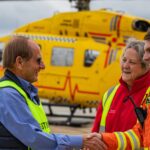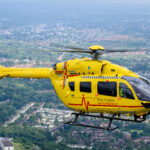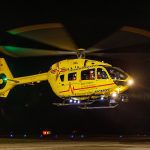21 Jul 2025
Farm Safety Week 2025
EAAA crews serve a community of over three million people in a variety of different landscapes. Attending in the region of 2,000 people each year in towns and cities, beaches, our road network and the countryside of Bedfordshire, Cambridgeshire, Norfolk and Suffolk, we’re ready to respond when the worst happens. As we mark Farm Safety Week (21 – 25 July), we’re looking at some of the crew’s key considerations when tasked to rural and farming areas to support our vital farming and agricultural communities in the moments when they need us most.
A range of incidents
EAAA crews attend a wide range of medical emergencies in our region, and the same is true for incidents on farms. This can include cardiac arrests, falls, and traumatic injuries from machinery or livestock but, whatever the medical emergency, our crews will respond 24/7 by air and road at a moment’s notice.
Injuries on farmland can be difficult and challenging due to location, the nature of the environment and the machinery and equipment on site. Our helicopters and critical care cars mean we can reach the most seriously ill and injured people in our region to bring them urgent critical care in the fastest time possible – whatever their location.
Livestock
We’re acutely aware and respectful of the vital work of our farming communities, including livestock that may be on farmland. Our pilots will avoid flying over livestock wherever possible and will choose a safe and suitable landing site away from animals, such as cattle and horses. This is to reduce the chances of the aircraft startling the livestock or causing them distress due to the helicopter’s powerful downwash. An additional consideration is the safety of the crew when exiting the aircraft and not putting them at any risk due to distressed animals.
Landing sites
With farmland often being more remote, access to the incident location is sometimes more challenging for land ambulances, but an EAAA helicopter may be able to land closer to the scene so that EAAA clinicians can bring critical care to the patient in the fastest time possible. The What3Words app is useful in helping to identify exact locations.
As with all potential landing sites, pilots will apply the ‘5 S’s and a D’ criteria: Size, Shape, Slope, Surface, Surround, and Downwash before committing to a landing. This is to determine the safety and suitability of a landing site. Recirculating dust and hay may present visibility challenges; therefore, pilots may use the autopilot functions of the helicopter to wait in hover for any debris to safely disperse.
Outbuildings and their structural integrity are an additional consideration. Again, pilots will often land further away to reduce the likelihood of any damage to property.
In efforts to not damage crops, pilots will endeavour to land in crop tramlines. These are deliberate gaps in between crops, which farming machinery can pass through – but they are also a useful landing area for air ambulances too! While doctors and paramedics are treating a patient, pilots will endeavour to speak with landowners to answer any questions they may have about the chosen landing site.
A different environment
Once on scene and at a patient’s side, EAAA doctors and critical care paramedics operate with total patient focus and are especially mindful of some of the challenges that treating a patient on a farm could bring, such as additional risk of infection due to factors like mud and animal waste. The advanced medication carried by EAAA includes antibiotics. These can be given when a patient sustains an open fracture to reduce the risk of infection.
Support for our farming and agricultural communities
Our relationships with our local farming communities are key. Their support for EAAA is incredible, and we’re privileged and humbled that we can support them, not only in their time of need, but in a preventative capacity too. Our CPR training team recently carried out some CPR training for local Norfolk farmer and former EAAA patient, Tim Papworth, and his staff as part of a health and safety training day for Tim’s workforce. This training helped to equip them with the skills that could start the chain of survival before the arrival of the emergency services.
We hope that people never need to use these skills or need critical care from the EAAA crew, but if they do, we’re proud to stand beside and support our farming and agricultural community 24/7, all year round.




